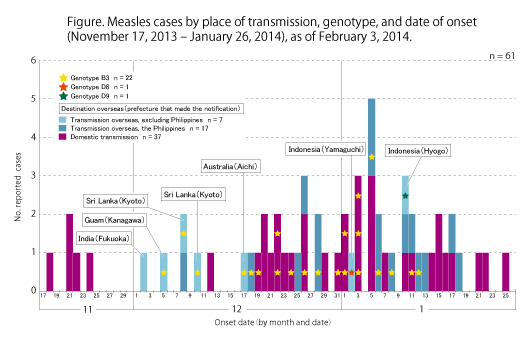|
 
Measles Increase in imported measles cases, epidemiologic week 48, 2013 – Epidemiologic week 4, 2014
During epidemiologic weeks 1-4, 2014 (December 30, 2013 – January 26, 2014), 46 cases of measles were diagnosed (see latest epidemiologic curve of measles: https://www0.niid.go.jp/niid/idsc/idwr/diseases/measles/measles2014/meas14-04.pdf ), indicating a considerable increase relative to the same period in the previous year. As of February 3, 2014, 16 cases have been genotyped for measles virus (for more information, see isolation/detection of measles virus in Japan http://www.niid.go.jp/niid/en/iasr-measles-e.html).
During epidemiologic week 48, 2013 to week 4, 2014 (November 25, 2013 – January 26, 2014), as of February 3, 2014, 61 cases of measles were diagnosed, 26 cases more than the same period in the previous year. Thirty-two of the 61 cases were male, with a mean age of 17.0 years (median 15 years, range 5 months to 60 years). Among the 24 cases that have been genotyped, 22 were B3 with one case each of D8 and D9 (Figure).

The number of cases reported by prefecture during this period was as follows: Kyoto (n=21), Aichi (n=8), Kanagawa (n=7), Tokyo (n=5), Okayama (n=3); 2 cases were reported from each of the following: Chiba, Fukuoka, Hiroshima, Hyogo, Saitama; and 1 case was reported from each of the following: Mie, Miyazaki, Niigata, Osaka, Shiga, Shizuoka, and Yamaguchi. Transmission occurred domestically in 37 cases (61%), with the remaining 24 (39%) having report of transmission overseas, with the largest proportion from the Philippines (Philippines (n=17), Sri Lanka (n=2), Indonesia (n=2), and 1 each in Guam, India, and Australia). Among the 61 cases, 52 (85%) had either no or unknown history of measles vaccination.
Importantly, from late 2013 to early 2014, the number of imported cases has been increasing. Among those believed to have been infected overseas, there was an average notification rate of 0.32 cases per week during epidemiologic weeks 1 to 47, 2013, relative to 2.7 cases per week during epidemiologic week 48, 2013 to epidemiologic week 4, 2014.
Regardless of age, measles is a potentially fatal disease and warrant vigilant attention. In addition, while there is no specific treatment, prevention is possible through immunization. Japan has achieved substantial progress toward measles elimination. Working toward elimination by 2012, there has been an estimated 97% decline in incidence since 2007-2008 when measles predominated among adolescents; the next target is achieving certification of measles elimination in 2015. It is imperative that imported cases continue to be monitored, and at the same time, to be alert against secondary transmission from imported cases. Thus, there is a need to respond to each case rapidly with epidemiologic investigation; additionally, measles vaccination (ideally MR vaccine) should be systematically implemented among those susceptible, particularly those who are targeted for routine immunization (age one year, one year period prior to elementary school attendance).
Furthermore, there has been increase in the report of measles cases among overseas travellers (or those linked to overseas travellers), with numerous cases believed to have been on board an airplane when they were infectious*. Healthcare workers should carefully investigate symptomatic persons regarding their travel, contact and immunization histories.
Travellers overseas should confirm their vaccination status and ensure that they are up to date with the necessary vaccines, preventing importation. Additionally, if measles is suspected, notification should be made prior to visiting a health facility to prevent secondary transmission.
For more information regarding measles, including previous trends, please visit http://www.niid.go.jp/niid/ja/diseases/ma/measles.html .
*ECDC Risk assessment guidelines for diseases transmitted on aircraft (RAGIDA). Part 2: Operational guidelines Second edition
http://www.ecdc.europa.eu/en/publications/guidance/Pages/index.aspx
http://www.niid.go.jp/niid/images/idsc/disease/measles/pdf/20140205/koukuuki.pdf
Infectious Disease Surveillance Center,
National Institute of Infectious Diseases
Takuri Takahashi, Tomimasa Sunagawa, Hitomi Kinoshita, Kazuhiko Kanou, Hiroaki Ito, Kazutoshi Nakashima, Satoru Arai, Hiroshi Sato, Keiko Taya and Kazunori Oishi
|
|
